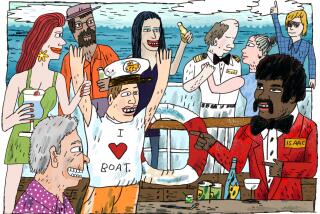What goes into the planning of itineraries
- Share via
When vacationers shop for a cruise, some choose their favorite cruise line or ship, and others look for sailings close to home. But for many, the itinerary is the most important factor. So how do cruise lines decide where to send their ships?
It’s not as simple as sticking pins in a map and drawing a line to connect the points. The planning starts 18 months to two years before the brochures are printed. With such a long lead time, cruise line planners must gauge where passengers will want to go in two years. Mimi Weisband, spokeswoman for Crystal Cruises, says that the company is now planning the schedule for the 2004 world cruise of its new ship Crystal Serenity.
But sometimes planners guess wrong. Two years ago, Radisson Seven Seas thought South America would be a popular route for its ship Song of Flower, but the demand wasn’t there, so the ship was taken out of service.
Several factors can affect itinerary, among them world events, crime at ports of call, marketing and season.
Events can always force an immediate unplanned change in itinerary. Several cruise lines canceled calls in Indonesia after the Bali bombing in October. After the Sept. 11 attacks last year, Crystal Cruises diverted a ship scheduled to sail through the Suez Canal to a route around the Cape of Good Hope and along the west coast of Africa. Carnival redeployed a ship to New Orleans from San Juan, Puerto Rico, because many passengers were unwilling to fly to the Puerto Rican port.
Moves to smaller ports were afoot at Carnival before Sept. 11, said company spokeswoman Jennifer de la Cruz, because of marketing needs and new ships. De la Cruz said Carnival had been moving ships to smaller ports along the East and Gulf coasts before the attacks, the result of a marketing plan to make it easier for passengers in less common home ports to take a cruise. The company added Tampa, Fla., then New Orleans; Galveston, Texas; Charleston, S.C.; and now Norfolk, Va.; Baltimore; and Philadelphia.
Crime was a factor when Carnival and Holland America decided to stop calling at St. Croix in the U.S. Virgin Islands this year. Unrest and an increase in kidnappings of foreign nationals in Venezuela caused some lines to cancel calls at its capital, Caracas.
Adding a new port of call to an itinerary requires planning. A stop must have adequate facilities for docking the ship or tenders and enough shore-side facilities and activities to interest passengers. The onshore infrastructure must be able to handle organized shore excursions; restaurants and shops have to be investigated, and security must be in place.
When you pick up a cruise brochure with its glossy photos, know that somebody has done a great deal of planning to make your journey a happy and fulfilling one.
*
Harry Basch travels as a guest of the cruise lines. Cruise Views appears twice a month.
More to Read
Sign up for The Wild
We’ll help you find the best places to hike, bike and run, as well as the perfect silent spots for meditation and yoga.
You may occasionally receive promotional content from the Los Angeles Times.






